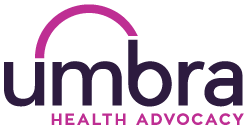How To Prepare For A Hospitalization: A Checklist

With thanks to advocate and guest blogger, Kim McIlnay.
Find Kim's advocacy profile here: Together Patient Advocates, LLC
Under the best of circumstances, a hospital stay can be stressful and uncomfortable. The Covid-19 pandemic created new challenges, bringing uncertainty and isolation when many hospitals prohibited visitors. Even though many pandemic restrictions have eased up, we learned some good ways to prepare for a hospitalization that can still be useful.
These tips can help you prepare now for an improved hospital experience for yourself or your loved one (referred to as "the patient" for simplicity below).
Start the following tasks TODAY:
![]() Download the FaceTime (or other preferred video chat) app on your devices. Even if your visitors can visit you, video conferencing will help you stay connected in between visits. It will also help you stay connected with people who may not be able to visit in person. Video chat can also better facilitate communication with the medical team.
Download the FaceTime (or other preferred video chat) app on your devices. Even if your visitors can visit you, video conferencing will help you stay connected in between visits. It will also help you stay connected with people who may not be able to visit in person. Video chat can also better facilitate communication with the medical team.
![]() If the patient is unable to use a phone or tablet, consider using an old-fashioned tape recorder to pre-record messages from family and/or friends, favorite readings or favorite music. It can be sent to the hospital with the patient, and she or a friend or family member can request that it be played for her. Include a spare set of batteries.
If the patient is unable to use a phone or tablet, consider using an old-fashioned tape recorder to pre-record messages from family and/or friends, favorite readings or favorite music. It can be sent to the hospital with the patient, and she or a friend or family member can request that it be played for her. Include a spare set of batteries.
![]() Create and print a medical summary sheet. Place a copy in your “Go Bag” (see separate post on this topic). This sheet should include the following important medical information:
Create and print a medical summary sheet. Place a copy in your “Go Bag” (see separate post on this topic). This sheet should include the following important medical information:
-
- Name, date of birth and phone numbers
- Emergency contacts and their phone numbers and relationships. Include a physical address for priority emergency contact in event the hospital is unable to reach them by phone. Notate the patient’s medical power of attorney.
- Medical diagnoses/medical problem list/past medical history. This list includes the current diagnoses the patient’s doctor is treating, as well as significant past medical history. For example: High blood pressure, diabetes, heart disease, past history of bleeding from the stomach, past history of cancer years ago, etc.
- A complete medication list. Look at the actual bottles and include the medication name, dosage, when it’s taken and why. For example: Lisinopril 10 mg every morning for high blood pressure. Update this whenever there is a medication change.
- A list of medication and food allergies, including the reaction. For example: Penicillin causes rash.
- Doctors’ names and contact information
- Past surgeries and hospitalizations
- Any additional information you think is important for the doctor to know. For example, “Aunt Susie has dementia. Please make sure she is able to reach her brown teddy bear as it calms her.”
- Ideally, this medical sheet will be a single piece of paper, but complex histories require additional pages.
![]() If the patient has a smart phone, copy/paste the medical summary information into their phone's medical ID section so that the patient and care team will also have electronic access to it, should the paper version get lost. Iphone directions are here. Android directions are here.
If the patient has a smart phone, copy/paste the medical summary information into their phone's medical ID section so that the patient and care team will also have electronic access to it, should the paper version get lost. Iphone directions are here. Android directions are here.
![]() Review the patient’s Advanced Health Care Directive and POLST forms to ensure they still match the patient’s wishes. If these haven’t yet been completed, it’s time to do so. AARP provides a link to electronic forms for each state. Detailed information re POLST forms can be found here. A POLST form must be signed by your physician. You may be able to do this with the doctor via video visit.
Review the patient’s Advanced Health Care Directive and POLST forms to ensure they still match the patient’s wishes. If these haven’t yet been completed, it’s time to do so. AARP provides a link to electronic forms for each state. Detailed information re POLST forms can be found here. A POLST form must be signed by your physician. You may be able to do this with the doctor via video visit.
![]() Signed HIPAA or PHIPA release forms for the patient’s designated family member to be able to receive information and communicate with staff on the patient’s behalf.
Signed HIPAA or PHIPA release forms for the patient’s designated family member to be able to receive information and communicate with staff on the patient’s behalf.
-
- For California, I recommend using this form (find forms for other states by doing a search for your state, and "HIPAA" or your province and "PHIPA"). In addition, include a copy of the patient’s driver’s license with the form as medical records will require that to confirm validity.
- Consider leaving the facility name blank since the specific hospital is not yet known.
- Consider doing a second form for the patient’s preferred hospital (can be found by googling the hospital name and “release of information form” or "HIPAA" or "PHIPA").
- Under purpose, check “patient request” and write in “may speak to medical staff on my behalf” or “may speak to medical staff on my behalf only if I am unable to verbally consent during admission.”
![]() The patient needs to share their wishes with their family. I cannot stress enough the importance of doing this NOW: The Conversation Project is an excellent resource for reviewing wishes and prompting discussions. They also have an excellent section regarding specific considerations pertaining to COVID.
The patient needs to share their wishes with their family. I cannot stress enough the importance of doing this NOW: The Conversation Project is an excellent resource for reviewing wishes and prompting discussions. They also have an excellent section regarding specific considerations pertaining to COVID.
Hopefully, by preparing now, the stress of an actual hospitalization will be lessened and comfort during hospitalization improved.
Find a Health / Patient Advocate or Care Manager
Learn more about The Alliance of Professional Health Advocates
